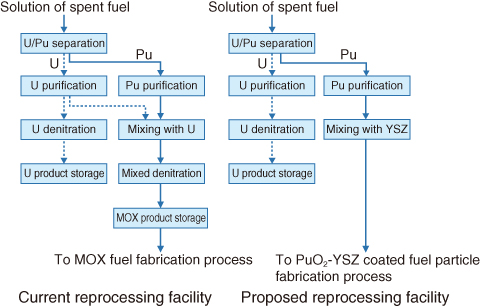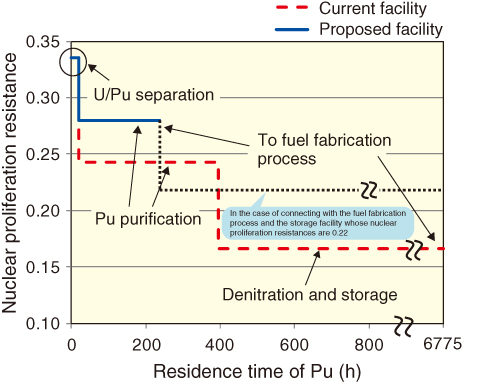
Fig.6-4 Pu flow in the reprocessing facilities

Fig.6-5 Nuclear proliferation resistance based on the AFCI method
We have been conducting a conceptual study on using a plutonium (Pu) burner HTGR system to achieve effective incineration of 239Pu, which is significant for nuclear non-proliferation in the long term.
In Japan’s reprocessing facility, Pu recovered from light water reactor spent fuel is mixed with uranium (U), as shown in Fig.6-4, to prevent an increase in nuclear proliferation risk by avoiding the existence of pure Pu. The Pu/U mixed solution line is connected to the denitration process, and then Pu/U mixed dioxide fuel (MOX fuel) is fabricated.
When used in a reactor, the MOX fuel generates additional Pu through a neutron capture reaction with 238U. In other words, more efficient incineration of Pu would require Pu fuel without U. One challenge to fabricating Pu fuel without U is how to do it without reducing nuclear proliferation resistance in the reprocessing facility. In the proposed reprocessing facility shown in Fig.6-4, Pu is mixed with yttria-stabilized zirconia (YSZ) instead of U. YSZ is essentially chemically inactive, and the Pu/YSZ mixed solution line is connected to the fabrication process for PuO2–YSZ coated fuel particles. The nuclear proliferation resistances of the proposed and current reprocessing facilities are evaluated quantitatively using the US Advanced Fuel Cycle Initiative (AFCI) method. The results in Fig.6-5 show that the proposed reprocessing facility is superior to the current system in terms of nuclear proliferation resistance. Additionally, the fabrication of PuO2–YSZ coated fuel particles is possible without major research or development, because a similar technology has already been developed and used for the fabrication of UO2 coated fuel particles for the HTTR.
PuO2–YSZ coated fuel particles are composed of 0.5-mm-diameter PuO2–YSZ kernels and four coating layers made of pyrolytic carbon and SiC. Owing to the use of YSZ as fuel matrix, it is very difficult to recover Pu from a PuO2–YSZ coated fuel particle. As a result, the PuO2–YSZ coated fuel particle is considered to have excellent nuclear proliferation resistance in many aspects including fuel fabrication, reactor operation, and disposal of the spent fuel. Additionally, the PuO2–YSZ coated fuel particle is excellent for safe geological disposal because the leach rate of the fission product in YSZ is two orders of magnitude smaller than that in glass.
A preliminary analysis has been performed for a Pu burner HTGR rated at 600 MWt to investigate the incineration rate of 239Pu. The result shows that 95% of 239Pu is incinerated by optimizing a fuel shuffling scheme. In future work, we will prepare the nuclear design of a Pu burner HTGR and a fuel design that would allow a very high burnup of around 500 GWd/t.